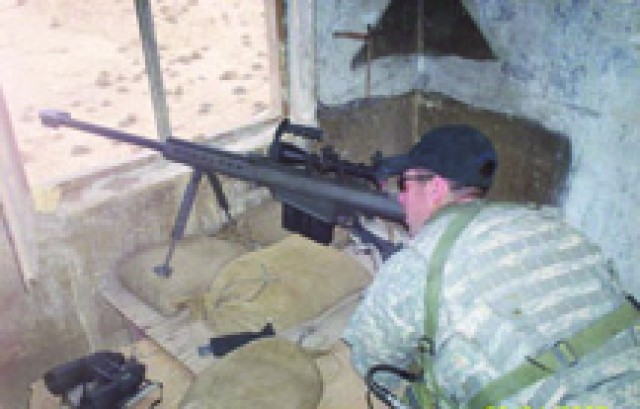FORT POLK, La. (April 19, 2010) -- The early morning April sky dawned clear over Forward Operating Base Iskandaryia, Iraq. Sgt. 1st Class Brandon McGuire, a platoon sergeant with 3rd Battalion, 509th Infantry Regiment, whose home base was Fort Richardson, Alaska, and his spotter settled in for their third day of looking for insurgents.
"We were observing a stretch of road that had recently been cleared of IEDs (improvised explosive devices)," said McGuire, now first sergeant of Fort Polk's Alpha Troop, 1st Battalion (Airborne), 509th Infantry Regiment.
"The area had also seen a lot of mortar activity. We had several Soldiers killed and severely wounded along that stretch of road by IEDs and mortars."
As the two Soldiers gazed across the expanse between their hiding place - an abandoned shed - and their target area, they noticed a man in local garb sauntering up and down through a series of canals. When he dug into a canal bank and uncovered a mortar tube, McGuire said he knew this was a target.
"We called the battalion TOC (tactical operations center) and reported what we had," said the Olathe, Kan., native. "We were granted permission to engage the target."
However, engaging the target was easier said than done.
"We measured the distance at 1,310 meters," McGuire said. "There was a crosswind of 8-10 knots and a sand storm was heading our way. We didn't have a lot of time."
Yet time was needed. Snipers are trained to make a triangle from a target's chin to his chest, and then aim for that mark. But McGuire's target was moving up and down through canals making it difficult for the Army marksman to get a clear shot. Then there were the calculations for windage.
Here, McGuire caught a break - there were kids not far from their target flying a kite. "We were able to use the kites to help estimate the wind speed at the target," McGuire said. "We watched for almost two hours before the target presented himself in such a way that I was able to get a clear shot."
McGuire said he didn't think he would hit his target with the first shot.
"I was hoping I would get close enough to make an adjustment and hit him with the second shot," McGuire said. "I knew that when I fired there would be a brown out for a couple of seconds - the dust would block my vision - so I was depending on my spotter to let me know where the first round hit."
McGuire took a breath and then squeezed the trigger of his Barrett .50 caliber sniper weapon system. After the dust cleared, McGuire prepared for a second shot, but was unable to find the target.
"I asked my spotter, 'Where is he''" McGuire said. "My spotter said, 'Holy s--, I think you got him."
McGuire said that for a couple of seconds there was disbelief on his part. Then it was back to work scanning the sector for targets.
The shot was so effective no one knew about it other than McGuire, his spotter - and the target.
"Even the kids flying the kites were oblivious to what happened," McGuire said. "They just kept flying their kites."
With the shot, not only had McGuire removed a target that had helped kill and wound American Soldiers, he had also dealt a psychological blow to the enemy.
"No one knew who shot him," McGuire said. "Not even the local elders. They came to our FOB and told us a member of the mortar team had been killed, but they didn't know who did it. It hurt them bad because they didn't know who was targeting them. It took a mental toll on them."
The shot had an opposite affect on U.S. Soldiers.
"For us, it was great," McGuire said. "We'd had so many Soldiers killed and who had lost legs. After the shot, the daily mortar attacks and IEDs ceased in that area."
McGuire said "the million-dollar shot" as it became known among members of his unit, was a big deal to coalition forces in the area.
"Everyone was congratulating me," he said. "But to me, it seemed like another day in Iraq."
McGuire recently returned from a trip to California to film a segment of an upcoming History Channel special entitled "Sniper: The Deadliest Mission." The two-hour documentary is scheduled to air this fall.
"I spent a couple of hours in an interview, then shot the rest of the day with another sniper," McGuire said. "It was a lot of fun."
McGuire tributes the success of the improbable shot to tactical patience.
"It took us two hours to get the shot picture I needed on the target because of the terrain," he said. "We waited, then finally got the shot. Hitting a human target is not like a deer or something. "With an animal, you can kind of predict what their movements are going to be, but with a human, you don't know what they are going to do."


Social Sharing